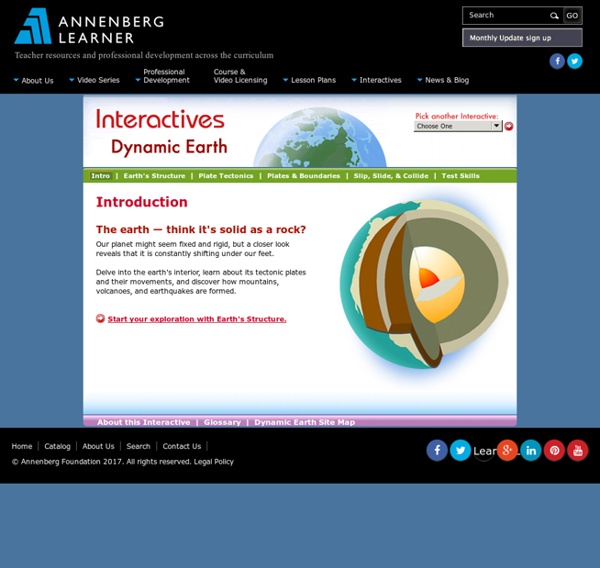



http://www.learner.org/interactives/dynamicearth/index.html
Related: Earth Sciences • ScienceGarbage If your habits resemble those of average Americans, you generate about 4.6 pounds of solid trash per day. This adds up to big trouble for the environment. Americans are generating waste products faster than nature can break them down and using up resources faster than they can be replaced. How can we find ways to meet our current economic and social needs without compromising the ability of our children, and our children's children, to do the same?
My Molecularium - Get the App for your mobile device! "Angry birds meets nanoscience, with this sling-shot style molecule building game...This is a fun game that is well worth the download." - Children's Technology Review My Molecularium is a fun and challenging molecule building game.Launch atoms at target bond sites to assemble essential molecules of increasing complexity and difficulty. Move your device to direct your shots using our innovative laser-guided aim. Learn to use the chemical and structural formulas to help you build a wide range of important molecules, from water and vitamin C to caffeine and adrenaline. Discovery Education - Curiosity in the Classroom Every school is different — and so is the technology that fuels your classrooms. We are committed to ensuring that our services are available on your platform of choice, whenever and wherever you need them, with the same high-quality experience every time.
USGS Schoolyard Geology Download this page as a Microsoft WORD document | Download this page as a PDF Document As a geologist, you need to practice describing rocks in detail. It's not enough just to say "it's a rock". You need to be very specific and mention each of the properties that make one rock different from another. Find a particularly interesting rock on your schoolyard. It can be either natural or man-made. Volcanoes Rock! / Themes gallery / Themes Read articles, look at photos, and watch video clips of New Zealand volcanoes and choose one that interests you to investigate further. Take a look at the New Zealand volcanoes and choose one to learn more about. On your computer, 'Bookmark' this webpage or add it your 'Favourites' so you remember where to find it again. Find out where it is in New Zealand and the name of the nearest town or city. Find out what type of volcano it is. Look at the diagrams of the three major types of volcanoes in New Zealand.
Weather New Englanders have a saying: "If you don't like the weather, just wait a minute." Weather forecasts may be more stable in other parts of the world, but the basic idea stands. Weather is dynamic, the product of interacting forces we are only beginning to understand. Witness the weather extremes caused by El Niño in 1997 and 1998. El Niño raised water temperatures in the Pacific and the effects were felt worldwide: crop failures, disease outbreaks, excess snow, or too little rain.
Virtual and Interactive Resources for Science Teachers Virtual labs have come a long way in recent years. While nothing compares to completing a hands-on lab in an actual science classroom, sometimes it isn't possible. Cost and access to equipment are possible obstacles.
USGS Schoolyard Geology The main purpose of this web site is to introduce teachers to the geologic features on their own schoolyard. We hope to open their eyes to the possibilities for teaching geology to students in a familiar, easily accessible, and personally relevant setting. We have divided the site into three individual lessons: Plate tectonics We can blame plate tectonics for many catastrophes over time – earthquakes, volcanoes, geothermal1 activity, tsunamis2 and landslides – while people living on mountain ranges or small islands can thank the work of plate tectonics for providing them with somewhere to live. So what are tectonic plates3 and how do they cause all this change? Tectonic plate boundaries